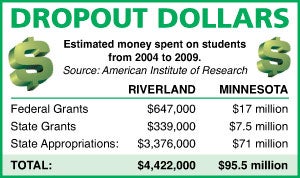Riverland spent millions on dropouts
Published 10:40 am Thursday, October 20, 2011
Riverland Community College used more than $4.4 million between 2004 and 2009 on students who dropped out after the first year of college, according to a new study by the American Institute of Research.
 The report, “The Hidden Costs of Community College,” states almost $4 billion in state and federal grant money and state funding was spent nationwide on first-year dropouts during that five-year period.
The report, “The Hidden Costs of Community College,” states almost $4 billion in state and federal grant money and state funding was spent nationwide on first-year dropouts during that five-year period.
“We have to pay attention to the costs to this problem because it’s costing the nation about $1 billion a year,” said Mark Schneider, AIR vice president and lead author of the study, which was publicly released Thursday.
According to AIR, Riverland received about $647,000 in federal PELL grants, $399,000 in state grants and $3.37 million in state funding from 2004 to 2009 to pay for students who dropped out after one year in college. In other words, Riverland lost out on that money since grants and state funding depend on tuition and enrollment.
Riverland’s dropout losses are average compared to other Minnesota community colleges. Riverland’s student retention rate is at about 84.1 percent based on data from the U.S. Department of Education. A higher retention rate means Riverland is keeping more students, and therefore more dollars in state funding and state and federal grants than other schools. Riverland is among the top 10 community colleges in the state when comparing retention. Community colleges like South Central College and Ridgewater College, which Riverland officials often compare the school to, have retention rates of 83.8 percent.
Ridgewater spent about $7.7 million and South Central spent about $5.6 million from 2004 to 2009 on first year dropouts.
Yet Riverland ranks in the middle of Minnesota community colleges in the costs of first-year dropouts. Riverland spends about $800,000 a year on first-year dropouts according to AIR estimates. Rochester Community Technical College spends about $1.8 million a year, the second highest amount in the state.
The report gives several widely accepted reasons why students are dropping out of college after just one year, such as students who work full-time jobs who can’t afford the time or money to continue their education. Higher education experts say many students are coming to college under-prepared as well.
“Many of the challenges facing community colleges can be traced to the inadequate preparation for college-level work students receive in high school,” wrote Dominic Brewer, Clifford and Betty Allen, education professors at the University of Southern California in a commentary on the AIR study.
Riverland officials say they’re already identifying ways to keep students on campus.
“We are putting a real focus on retention,” said Ron Langrell, Riverland Vice President.
Riverland officials identified student retention as an issue in 2008 based on Minnesota State Colleges and Universities data. Riverland officials found about 66.9 percent of students came back to Riverland in their second year, not counting graduation or transfers. Riverland hopes to raise student retention to 73 percent by 2012-2013 through focusing on remedial courses and getting students more help from faculty and tutors outside the classroom.
“Sometimes we have to go back to the basics before we can ladder onto the stars,” said Danielle Heiny, Riverland’s director of retention and student success. “Our role is to really give everybody a chance at education.”
Riverland officials have developed more tutoring programs through the Student Success Center, which Heiny said is catering to about 100 students this fall compared to about 70 students who sought out tutors last year. Riverland also hopes to put more students into class cohorts, which are groups of students who progress through a department or program by taking the same classes together.
Heiny touted the Early Intervention Extra Interaction Often program as one of Riverland’s key retention programs. If a student earns less than a 2.0 GPA and fails more than 2/3 of their credits at the end of a semester, counselors will meet and give the student an academic warning. The counselor and student will create a success contract to help the student get their grades up. Counselors will then meet with that student regularly throughout the next semester to check their progress.
“We’re going to be doing a better job of tracking what happens to those students,” Heiny said.
Riverland President Terry Leas was unavailable for comment.





